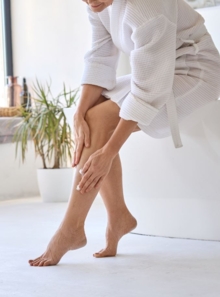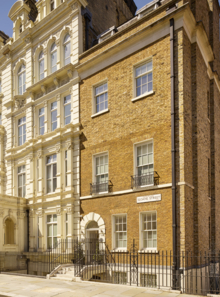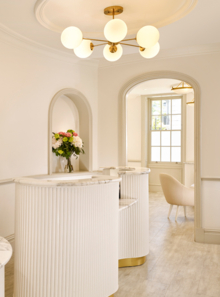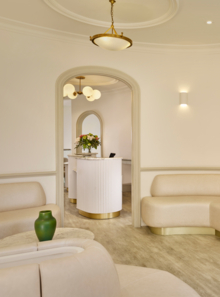Medically Reviewed October 2023,
by Mr. Bryan Mayou (GMC: 1414396) - founder of the Cadogan Clinic and one of the world's leading plastic surgeons
What is toe shortening and straightening?
Toe shortening and straightening are surgical procedures which address common concerns of the toes, such as hammer toes, crooked toes and angular toes. Concerns around the toes can be uncomfortable and cause difficulties in wearing certain shoes, as well as causing the patient to feel self-conscious about the appearance of their feet.
Depending on the severity of the case, several methods can be used to surgically shorten and straighten toes. The surgery typically involves removing a portion of the bone at the contracted joint, to realign or reshape the toe. A metal pin, screw or plate may be placed in the toe to secure the joint during recovery. We are also well placed to perform toe fusion surgery, which may be necessary if you are experiencing complications with arthritis, a bunion, or other complex deformities.
Our experienced specialist surgeons can advise on the best approach for you if you are experiencing discomfort because of your toes, or you aren’t happy with their appearance.
Get in touch
Why do people have Toe Shortening and Straightening?
The three most common conditions that people are looking to address through toe straightening or shortening are:
Crooked toes
There are many different types of crooked toe.
- Mallet toe - a sideways bend in the top joint of the toe.
- Overlapping toes - one toe is bending sideways to sit on top of an adjacent toe.
- Adductovarus toe - is a rotated or twisted toe.
Crooked toes may not cause any pain or discomfort and can correct themselves in time. Lifestyle changes, such as changing your footwear or losing weight, may relieve crooked toe symptoms. However, some crooked toes can cause pain, lack of mobility and further foot concerns such as corns, calluses and open sores. Crooked toe surgery may involve cutting or removing some of the toe joint and rotating the toe to make it straight.
Angular toes
Angular toes are caused by the presence of a bunion lowest joint of the big toe, causing the big toe to point inwards, towards the other toes at an angle.
Angular toes and bunions can be painful and make it uncomfortable to walk, putting further strain on other joints such as the ankles and knees. Toe straightening surgery will address the angle of the toes as well as removing the bunion. This may be a case for big toe fusion surgery, depending on the severity.
Hammer toes
Hammer toe is a common deformity that causes toes to bend downward instead of pointing forward. This can cause significant pain and difficulty in wearing shoes comfortably. Hammer toes will progress over time until the toes become dislocated. It can occur in any toe, but most often appears in the second or third toes. Although a hammer toe may be present at birth, it most often develops over time. If you are unable to flex your toes, then hammer toe surgery is the only option to restore movement.
There are a few factors that may cause toe concerns including tight or poorly fitting footwear, joint or nerve damage, obesity, arthritis, or an hereditary condition. All these conditions can also be caused by previous injury or trauma, for example, a broken toe that did not heal properly.
Patients choose to undergo surgery to treat these conditions as they are experiencing pain and discomfort in their feet, and other parts of the body, or because they are unhappy with the appearance of their feet.
The cost of Toe Shortening and Straightening
Cadogan Clinic has collaborated with Chrysalis Finance to offer a variety of payment choices for our patients including:
12 months 0% Interest-free - APR
24 - 60 months at 12.9% APR
Flexible Finance
What is the toe shortening procedure?
Toe procedures vary, depending on the exact concern that is being treated. Most procedures take 1-2 hours and are carried out under general or local anaesthetic depending on what your surgeon has recommended in your plan.
Toe shortening surgery
Toe reduction surgery helps to eradicate common toe deformities, such as an over-long second toe known as Morton’s Toe which may result in hammer toes developing. There are two different methods of toe reduction. These are joint resection (arthroplasty) or bone mending (fusion). The technique used depends on exactly where the toe is too long or is employed at the site of any buckling of the toes.
During toe shortening surgery, the surgeon will carry out a digital arthroplasty, involving removing some or all the small bone that forms the joint within the toe. Once the toe or toes are shortened to the desired length, a small pin or wire may be inserted to hold the newly shortened toe in place to help the toe retain its flexibility. An over-long second toe nearly always requires this medical hardware to aid healing and to keep the toe fixed in its new position whereas the fifth toe rarely requires any wire or pinning.
Toe straightening surgery
Toe straightening surgery can be carried out on one or several toes during a single procedure. This surgery restores a natural appearance to your feet by correcting misaligned toes that may be bent or out of proportion to the others. Misaligned toes are often related to the presence of bunions, a prominent bump at the base of the big toe. Toe straightening surgery is for people who have crooked or angular toes, which may be caused by a bunion.
The surgeon will begin by making an incision along the top of the affected toes. The joint at the base of the toe is loosened and the surgeon may decide to remove some of this bone from the joint to allow for a full correction. Bone is removed from the middle joint of the toe to reshape and straighten the toes. The surgeon may also reroute a tendon from the underside of the toe to the top of the toe to enhance the result. A pin is inserted into the toe tip to stabilise the now straightened toe and maintain the result.
Who is suitable?
At Cadogan Clinic, our consultant surgeons will assess whether you are suitable for toe straightening surgery or shortening in a bespoke one to one consultation.
Your surgeon will examine your feet and toes and explain the exact problems you are experiencing, if you haven’t been previously diagnosed. They will discuss your expectations of surgery and ensure you understand the results that are possible for you. They will also assess your general physical and mental health to make sure you are suitable for a general anaesthetic procedure, this may include your weight, and any medical and mental conditions you have.
You must be over 18 to have this procedure.
Toe Shortening and Straightening Surgeons
We have invited a selection of the country's very best consultants to join us at the Cadogan Clinic so that you can be sure that whatever the nature of your treatment, you will be seeing one of the top practitioners in the country.
Toe Shortening and Straightening Procedure
What can you expect from your surgical journey with Cadogan Clinic and how should you prepare for toe straightening surgery?
A thorough and comprehensive consultation process
You will have up to two 60-minute consultations with your specialist podiatry surgeon at our Chelsea based clinic to discuss your concerns around your toes and the results you are looking for. Your surgeon will take the time to explain the best procedure for you and how this would be carried out, as well as giving you an indication of the results you can expect by sharing previous before and after photos with you.
To get the most from your consultation, we recommend writing down any questions you have for your surgeon in preparation. This ensures you don’t forget anything that is important to you and your surgeon can steer the conversation in the right direction for you.
During your consultation your surgeon will also conduct a full health and wellness assessment, take measurements of your toes and feet and capture photographs for your medical record.
Once your surgeon has prepared your surgical plan, they will send it through to your patient advisor. Your patient advisor will contact you to discuss the procedure your surgeon has suggested as well as the price and available surgery dates that may suit you. You will then have a two-week cooling off period to consider your options and decide whether you wish to undertake the toe shortening and straightening surgery.
Pre-surgery preparation
In the weeks running up to your surgery, you will be asked to prepare using the following steps:
- You will be asked to complete your pre-operative paperwork for your surgical team to review and approve you for surgery.
- Your surgeon will ask you to stop smoking and/or vaping for six weeks before your surgery can take place. This ensures you heal fully and properly in a shorter time frame.
- You will also be asked to cut down on drinking alcohol as excessive alcohol consumption can also impact the healing and recovery process. In the final 48 hours before surgery, you shouldn’t consume any alcohol.
- Don’t take anti-inflammatory medications such as ibuprofen and aspirin, or any herbal supplements as these can increase the risk of bleeding in the week before your surgery.
- Please organise for a family member or friend who can either drive you or accompany you in a taxi and stay with you for the first night to collect you after your procedure.
- You mustn’t eat any solid food or consume any juice or milk (including tea or coffee) in the 6 hours before you arrive at the clinic. You can have sips of clear liquids (water, or black tea and coffee) up to 2 hours before you arrive at the clinic.
Your surgery day
Your arrival time at the clinic will be an hour before your surgery is due to begin. You will be taken into our pre-operative assessment area, where a nurse will check your vital health signs and ask you to dress in a surgical gown with compression stockings. Your surgeon and anaesthetist will then answer any final questions you have, and your surgeon will make any markings they need to carry out your procedure.
You will then be taken into theatre. If your procedure is being carried out under general anaesthetic so you are completely asleep, this will be administered by your anaesthetist. All general anaesthetic procedures at Cadogan Clinic are performed with TIVA (Total Intravenous Anaesthesia) which reduces nausea while you are recovering and allows you to wake up faster. If your procedure is being undertaken with local anaesthetic, your surgeon will administer this.
Your surgeon will then carry out the procedure. Once your procedure is complete, you will be taken first to our recovery ward and then to our ambulatory ward. In our recovery ward, the nurses will monitor your vital signs and let you wake up from the anaesthetic. In our ambulatory ward, you will have your own room, where you will be given some food and drink and can spend a few hours relaxing. When you are ready, the nurses will prepare you to be discharged by explaining any medication and aftercare you need and calling your chaperone.
Treatment recovery
Following toe shortening and straightening, you will be asked to minimise any movement for up to two weeks. This helps your toes to heal effectively and maintain the shape the surgeon has created.
One week after your surgery you will have a check-up with our nurses to monitor your healing and provide any advice you need about your dressings. You will then return, two weeks after your procedure, so your stitches and any temporary pins or plates can be removed. However, for your second toe fusion surgery recovery time, you may need further appointments every 3-4 weeks so we can continue to check if the toe has fused yet. If it hasn't, you will be asked to wear a splint and you will be invited back to the clinic for further follow-ups.
All being well, six weeks after surgery, you have an appointment with your surgeon where they will assess your recovery and discuss your results. They will be able to answer any questions about what you should expect going forward before signing you off. If you have any questions beyond this point, you will still be able to speak with our nurses, and if necessary, book further follow ups with your surgeon.
The Patient Journey. A breakdown of what you can expect on your journey with us

We are deeply invested in ensuring that every step of your surgical journey with us is as informative and reassuring to you as it can be. This article outlines what you can expect at each stage of the journey
The Patient Journey
Frequently Asked Questions
How long is Toe Shortening Surgery Recovery?
Recovery from toe shortening surgery, or any other type of toe surgery, varies depending on which method was used and which toes were operated on. You should keep the leg rested and elevated for 48 hours after surgery and mobilise when advised by your consultant. This will help the healing process.
You should be able to return to day-to-day activities, such as normal walking and driving, from two weeks, although this may take longer. The total healing process takes in the region of six to eight weeks. However a full recovery may take as long as six months. Factors that may delay the healing process include smoking and drinking alcohol. Keep wounds dry and clean.
It is vital that you follow all the aftercare advice issued by your surgeon. Failure to do so may delay the healing process or affect the final result.
As part of your toe shortening surgery at the Cadogan Clinic, you will have access to comprehensive, 24/7 post-operative aftercare courtesy of our specialist cosmetic nurses.
How soon can I walk after toe shortening or straightening?
You can expect to be walking within a week of your toe shortening or toe straightening surgery. But this time frame varies depending on which toe or toes were operated on, the severity of the operation and which surgical methods were used. In general, you can expect a faster recovery time if the surgery only involved the fourth or fifth toes. It may take slightly longer to return to walking if the second toe was operated on. This is because the second toe is longer and is used to ‘push off’ while walking. You may find that it also takes longer to return to normal footwear if the second toe has been operated on. Your consultant will be able to advise you further on this.
What footwear will I need following surgery?
Depending on the type of surgery you have and how many toes are being operated on, you may be asked to wear a stiff soled surgical shoe following your toe surgery. This open-toed footwear may be required for up to four weeks. After this surgical shoe is no longer required, your surgeon may suggest wearing a wide, soft, deep shoe for comfort and to help with the healing process. By around the six week mark you should expect to be back in ordinary, closed-toe, footwear.
But as mentioned above, every case is different. Your surgeon will be able to advise you on how long you will need to wear surgical footwear ahead of your surgery. Book an appointment with one of our experts who will be able to discuss potential toe shortening, toe straightening or hammer toe surgery with you at our London clinic.
What are the causes of a long toe?
There are several causes of a long toe.
When the second toe appears longer than the big toe, this is called a Morton’s Toe. This is a common hereditary condition.
A bunion may also cause the second toe to appear longer. This is because this bony lump on the outside of the big toe can cause the toe to bend towards the other toes, making one, or several, appear longer.
If a bunion is the cause of your long toe or toes, then surgery to remove the bunion will be required in order to return the toes to their normal size and shape.
Bunions can cause crowding of smaller toes, which may result in hammer toes or similar foot deformities developing. Bunion removal surgery can help to prevent any further problems. A bunion will not go away by itself.
Why is my second toe longer? What is a Morton's Toe?
A long second toe is also known as Morton’s Toe. It is a common hereditary condition.
In the human foot, the long bones that connect the toes to the back of the foot are called metatarsals. The first metatarsal, the one you will find on the big toe, is the thickest.
In people presenting with Morton’s Toe, the first metatarsal is shorter compared to the second metatarsal, which makes the second toe appear longer than the big toe. This may cause foot aches and pains as this structural deformity puts more weight on the second, thinner, metatarsal bone. People with Morton’s Toe may find they are more prone to calluses developing where the long toe rubs on footwear.
If your second toe is longer than your big toe, you are at a greater risk of developing hammer toe or mallet toe.












